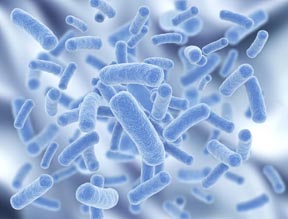Data analyzed at the University of Alabama at Birmingham was part of a massive national effort to catalog the typical mix of microbes living on the skin, up the nose and in the mouth and gut of a healthy American. The results — a series of reports to be published June 14, 2012, in Nature and in several Public Library of Science journals — could revise the understanding of the immune system and the ways in which these microbes cause disease.
 |
| E. coli |
To define the normal human microbiome for the first time, researchers from 80 institutions spent five years collecting and sequencing as many as 18 separate samples from each of 242 healthy U.S. volunteers under the auspices of the Human Microbiome Project Consortium, funded by the National Institutes of Health.
“With the character of the healthy microbiome now defined in one Western human population, the field can begin the search for bug profiles that correlate tightly with disease and the body’s ability to fight it,” said Peter Mannon, M.D., professor in the UAB School of Medicine Division of Gastroenterology and Hepatology and an author of the lead Nature paper.
“This reference database lays the foundation for advances in infectious, autoimmune and inflammatory diseases and potentially the identification of unique probiotics or even prescription fecal transplants to replace disease-causing microbiomes,” Mannon says.
Surprisingly, the data reveals that nearly every healthy person’s microbiome includes potentially dangerous, disease-causing bacteria. We mostly keep them under wraps, according to one theory, because of helpful bugs we inherit from our mothers that are so perfectly adapted to us that they out-compete the dangerous ones.
Other work suggests that our vertebrate ancestors first “invited in” gut bugs some 450 million years ago because doing so let them harness bacterial enzymes to get more energy from more kinds of food. These results take this notion to the extreme, with researchers reporting that microbes contribute 360 times as many genes responsible for the human ability to convert food into energy as human genes themselves. Some experts posit that humans and their bugs now represent a single super-organism.
| Nearly every healthy person’s microbiome includes potentially dangerous, disease-causing bacteria. |
HMP researchers also now calculate that more than 10,000 microbial species occupy the human ecosystem, but past efforts had isolated only a few hundred. Though the makeup of the microbiome is fairly stable within any individual, it can change, according to study observations, especially during sickness and antibiotic treatment. Also, though each person’s microbiome comprises differing amounts of bacterial species, the healthy study population generally uses the same types of bacteria to digest food, build vitamins and more.
In terms of clinical impact, tomorrow’s publications cover studies that found associations between the microbiome and health or disease. One found that the vaginal microbiome undergoes a dramatic shift in bacterial species before delivery to make the birth canal, which gives the baby its first dose of microbes, more tolerable to the newborn.
Another study found that in cases where only one of two identical twins has Crohn’s disease, differences in the microbiome between them might reveal environmental factors that drive the inflammatory bowel disease in one rather than the other despite similar genetic background. Along these lines the HMP study found that bacteria in the genus Faecalibacterium were present in 99 percent of healthy adults, though other reports show it occurs much less frequently in patients with Crohn’s disease and autoimmune Type 1 diabetes. Together the findings suggest a protective role for this microorganism in maintaining a healthy gut.
“The importance of understanding the composition of the gut microbiome and the body’s response to it cannot be overstated,” said Mannon. “In nearly every animal model of colitis, for example, animals do not develop inflammation when they live germ-free with no microbiome.”
Spiders don’t get inflammatory bowel disease
Still, HMP study revelations merely scratch the surface of the microbiome’s implications for human health, according to UAB experts working independently of HMP studies. If validated, emerging theories could drastically revise the understanding of the evolution of the human immune system and the ways in which microbes cause disease.
A research group headed by Casey Weaver, M.D., professor in UAB Department of Pathology, in 2005 discovered that a distinct population of immune cells (T helper 17, or Th17 cells) are tasked with deciding which bugs are good or dangerous at the borders of the human gut. Weaver and Robin Hatton, Ph.D., an assistant professor also in the Department of Pathology, have proposed that Th17 cells are the most ancient type of helper T cell, and that they might have emerged in early vertebrates to foster the development of a diverse microbiota that extended the metabolic capacity of the host. If true, the immune system’s ability to repel unwelcome invaders in general might represent a lucky, evolutionary after-effect of its more ancient role — managing a stable of helpful bacteria.
But evolution is imperfect. All the genes of all the bugs in the human body and all the proteins they produce may contribute significantly to the inflammation known to drive autoimmune, cardiovascular and neurological diseases, cancer, diabetes and obesity.
“Given the microbiome comprises 10 times as many cells and 100 times as many genes as all other cells in our body, how often do the products of the genes expressed by our microbiome look very similar to gene products expressed by human cells?” asks Weaver.
“How often then do immune responses that start at the barrier surrounding our gut trigger system-wide immune reactions that mistakenly cause never-ending inflammation? This is a risk of harboring a diverse microbiota and having an immune system that can sense and remember its members, features that appear to be unique to species with more advanced immune systems. Maybe this is why animals like spiders, invertebrates with limited gut bacteria, don’t develop autoimmune diseases such as inflammatory bowel disease or rheumatoid arthritis.”